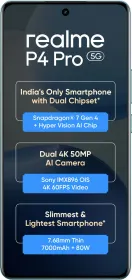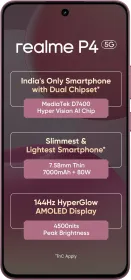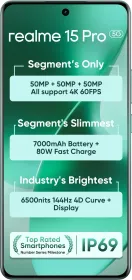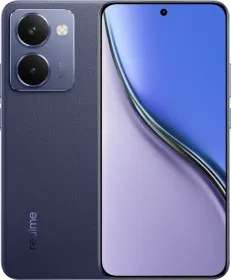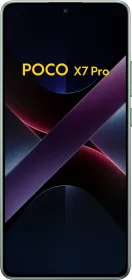The realme P4 Pro 5G is the latest mid-range contender in Realme’s popular P-series, a lineup that has built its reputation on delivering value-for-money smartphones for everyday users, semi-performance enthusiasts, and budget-conscious gamers.
This year, however, Realme is taking a bolder step. For the first time, the company is deploying a dual-chip architecture, pairing the Snapdragon 7 Gen 4 processor with a dedicated Hyper Vision AI Chip. On paper, this combo promises better performance, thermal management, and visual processing, all aimed at leveling up the mobile gaming experience without breaking the bank.
But does this strategy actually deliver in real-world use? After spending two months testing the Realme P4 Pro 5G across gaming, daily use, camera performance, and battery endurance, here’s my in-depth review with the highs, the compromises, and whether it’s worth your money in 2025.
realme P4 Pro Price & Availability
The Realme P4 Pro 5G was launched in India on August 20, 2025, and is available for purchase online via Flipkart, realme.com, and mainline stores.
The price for the P4 Pro 5G starts at ₹24,999 for the base variant with 8GB RAM and 128GB storage. With bank offers, the effective starting price can go down to ₹21,999. It is also available in 8GB + 256GB and 12GB + 256GB variants at higher price points.
Pros
- Huge 7,000mAh battery with fast 80W charging
- Slim and lightweight despite a massive battery
- Smooth performance for daily use and gaming
- Bright, sharp display with good refresh rate
- Reliable biometrics and decent haptics
Cons
- Cameras underwhelm for the price
- Speakers lack depth, no Dolby Atmos
- Realme UI still feels cluttered
- Dual-chip hype doesn’t fully translate
realme P4 Pro Review: Design and Build
The realme P4 Pro 5G has gone all in on aesthetics this year, giving the device a quad-curved display, ultra-thin bezels, and a back panel that feels a notch above its price tag.
realme is also experimenting with textures and finishes this time. The Birch Wood variant has a matte, wood-like back that cleverly resists smudges, while Midnight Ivy offers a darker, minimal matte finish.

These little touches give the P4 Pro a semi-premium feel, even though the body is still polycarbonate with a plastic frame. It’s not glass, but the finish and curves almost trick you into believing it is.
At just 7.7mm thin and weighing 189 grams, it’s remarkably slim and light, especially considering it packs a massive 7000mAh battery. The weight distribution also deserves credit. Some big-battery phones feel top-heavy and clunky; the P4 Pro doesn’t. The phone sits comfortably in hand, with just enough heft to feel solid without tipping into bulky territory.

The camera module also feels thought-out rather than slapped on. The metallic finish stretches across the top, neatly housing three lenses without making the phone wobble on a desk.
That said, not everything is an upgrade. The P4 Pro is rated IP65 and IP66, which means it’s dust-tight and can shrug off water jets. Decent, yes, but a step down from last year’s P3 Pro (which had IP66/68/69) and even Realme’s 15 Pro with its higher IP68/69 protection. It’s still durable, but Realme clearly trimmed here.
realme P4 Pro Review: Display

If there’s one thing Realme wants you to notice on the P4 Pro 5G, it’s the screen. And honestly? It delivers mostly. The phone packs a 6.8-inch 1.5K Display with curved edges, and it looks like it was ripped straight out of a premium flagship.
It is one of the brightest displays in the segment with numbers like 1000 nits typical brightness, 1800 nits in High Brightness Mode, and a 6500-nit local peak. It is legible in both indoor and outdoor conditions, even in direct sunlight.
The P4 Pro boasts a 144Hz refresh rate, but in reality, the UI and most apps hover at 120Hz. Only a handful of native apps touch 144Hz, and unless you spend a lot of time searching, you’ll rarely see it. It feels less like a feature and more like a spec-sheet stunt. Still, scrolling is fluid, and the 240Hz touch sampling rate keeps gaming decently responsive. Just don’t expect this to be a true 144Hz experience across the board.

realme is also using Hyper Vision AI Chip (Pixelworks X7 Gen 2), a co-processor to sharpen low-res content with AI Hyper Clarity, smooths gameplay with AI Hyper Motion (MEMC), and even forces SDR videos into HDR with AI Always-On HDR. On paper, it’s magic. In practice, it’s a mixed bag.
Upscaled YouTube videos genuinely look sharper, and games like BGMI benefit from the 1.5K + 144FPS pipeline. But MEMC-driven frame generation comes with a nasty trade-off with input latency. For casual players, it’s fine. For competitive gamers, those split-second delays can mean losing a firefight. And since the extra frames are system-generated, not rendered, eagle-eyed users might notice artifacts. It’s clever tech, but not flawless.
realme P4 Pro Review: Speakers and Haptics

The Realme P4 Pro 5G packs dual stereo speakers, with the earpiece doubling as a secondary driver. They’re loud and clear enough for everyday use and avoid distortion even at max volume. But the sound lacks depth and bass, with a slightly metallic tone and a noticeable imbalance, as the bottom speaker often outshines the top.
There’s also no Dolby Atmos support. Instead, Realme relies on its OReality spatial audio modes (Movie, Game, Music), which tweak the sound but don’t really elevate it to a flagship level.
On the haptic side, the X-axis linear motor delivers crisp, satisfying feedback when typing or gaming. But it’s oddly inconsistent — missing from system interactions like adjusting volume or swiping the app drawer.
realme P4 Pro Review: Software
The Realme P4 Pro 5G ships with Android 15-based Realme UI 6.0, which, let’s be honest, is essentially ColorOS in disguise. It’s smooth, has robust privacy tools, and Realme deserves credit for promising 3 years of Android updates and 4 years of security patches — a first for the P-series, and a welcome shift in a segment where long-term support is rare.

But it’s not without quirks. The UI occasionally lags in touch response, something Realme could patch, but still jarring on day-to-day use. And then there’s the bloatware problem: the phone comes preloaded with everything from Realme’s own Game Center, Hot Apps, and Finshell Pay to third-party heavyweights like Facebook, Snapchat, Netflix, and PhonePe. Sure, most can be uninstalled, but some creep back after a reset — a frustrating reminder that “value phones” still rely on bloat partnerships.


Where the P4 Pro flexes is in AI tricks. Realme throws in everything. AI Smart Loop for quick multitasking, Circle to Search for one-tap Google lookups, AI Gaming Coach with danger alerts in BGMI, AI Eraser, Unblur, and Reflection Remover for photos, and Even an AI Edit Genie, which lets you say “add flying birds” and watch them appear in your shot.
Some of this feels genuinely useful (AI Unblur, Gaming Coach), while others lean dangerously close to AI gimmicks that sound better on slides than in practice.
There are also thoughtful extras like an IR blaster with remote controls, Dynamic Island-style Live Alerts, and Realme Lab’s heart-rate monitoring via the fingerprint sensor. But no NFC support, and noted wireless Android Auto doesn’t play nice.
Realme UI 6.0 on the P4 Pro is feature-rich, AI-heavy, and update-friendly, but it’s weighed down by bloatware and small inconsistencies that prevent it from feeling truly refined.
realme P4 Pro Review: Performance

The Realme P4 Pro 5G isn’t shy about its ambitions. With Qualcomm’s Snapdragon 7 Gen 4 and Realme’s own Hyper Vision AI chip, this phone is built to flex benchmarks and gaming credentials. Realme uses its dual-chip setup to distribute workloads. The Snapdragon CPU handles raw power, while the Hyper Vision chip takes over graphics interpolation and frame boosts.
In day-to-day life, the phone performs as you’d expect, snappy, smooth, and mostly stable. Apps open quickly, RAM management is generous (with up to 14GB of virtual expansion), and there are no major lags in day-to-day use. That said, the occasional touch-response delays noticed are worth flagging. For a phone positioning itself as a performance-first device, even small UI glitches can feel jarring. Hopefully, Realme can patch this with an update.

It even cracked the 1M+ mark on AnTuTu, a figure that puts it ahead of nearly every rival in its price bracket. For gamers, realme pitches the P4 Pro 5G like a dream machine. It claims to run BGMI at 1.5K + 144FPS, maintains stability for seven hours, and even supports over a hundred titles at 144FPS. On paper, that’s ground-breaking for this segment.


While it does manage to achieve that claim but those 144 frame rates aren’t native. Realme is leaning heavily on AI-powered frame generation, which essentially creates virtual frames to smooth things out. In competitive titles like BGMI or Genshin Impact, this means extra latency, a dealbreaker if you play seriously. For casual players, though, the visual smoothness is addictive.
One of the boldest claims here is thermal performance. realme’s 7000mm² AirFlow VC cooling system covers more than half the phone’s internals, and it shows. Even after 90 minutes of heavy gaming, the P4 Pro doesn’t feel like it’s about to melt your palms. CPU temps drop by as much as 20℃ compared to rivals, and stability scores on 3D Mark back that up (98.4% in Wild Life stress tests).
realme P4 Pro Review: Cameras

Realme packs the P4 Pro 5G with a 50MP Sony IMX890 main sensor with OIS on the rear and a 50MP front shooter, both capable of 4K 60fps video. In daylight, the main camera delivers results that live up to the promise: crisp shots, natural colours, and decent dynamic range. The “vibrant” mode adds more punch, though it leans into saturation.








But the supporting 8MP ultrawide lens feels out of place in this setup. Its coverage is wide and dynamic range is okay, but the cooler tones and lower detail make it look like an afterthought, especially when rivals are shipping higher-res ultrawides in the same price bracket.


Night photography is a strong point. The IMX890 pulls in more light without introducing too much noise, and motion blur is under control. Colours, however, can shift under artificial light, sometimes appearing washed out. Portraits, both from the front and rear, are decent with clean edge detection and a pleasing bokeh, though skin tones veer towards overly smooth and warm.



The 50MP front camera handles skin tones and group selfies with finesse. But zoom performance is weak. Beyond 2x (or 10x if you’re generous), digital zoom quickly falls apart, leaving you with soft, noisy images.


This is where the P4 Pro 5G punches above its weight. 4K 60fps recording on both front and rear cameras, which is a good thing. realme also packs in AI Motion Stabilization, denoising, and HDR video recording. Casual vloggers and college creators will love this versatility.
That said, Ultra Steady is locked to 1080p 60fps, and the ultrawide can’t go beyond 1080p 30fps, limits that show where Realme cut corners. Still, for the price, video quality and stabilization are strong selling points.
Realme throws in a laundry list of AI tools – AI Edit Genie (voice editing), AI Eraser, AI Unblur, AI Travel Snap, Party Mode, and more. Some are genuinely handy (removing reflections or photobombers), while others feel like party tricks you’ll use once and forget. Features like AI Landscape often over-sharpen images, making them look processed rather than premium.
The Hypershot Architecture, however, deserves credit it delivering near-instant shutter speeds and reliable autofocus, which is crucial for fast-moving subjects.
realme P4 Pro Review: Battery Life and Charging

The 7,000mAh Titan battery on the Realme P4 Pro 5G is a monster, easily lasting two days with casual use and still giving 7+ hours of 144fps gaming. What’s shocking is how slim and light the phone feels at just 7.69mm and 189g.
Charging is fast but not record-breaking. The 80W Ultra Charge brick in the box gets you 50% in 25 minutes and a full charge in under an hour (sometimes a little more). Features like bypass charging for gamers and AI Smart Charging make it smarter than most midrange rivals.
If you hate battery anxiety, this is one of the best phones in its class, not the fastest to refuel, but easily the one that lasts the longest.
Long-Term Review Verdict: Should You Buy the realme P4 Pro?
The Realme P4 Pro 5G is Realme finally flexing in the mid-range. The massive 7,000mAh battery is absurdly good, the 144Hz AMOLED is smooth as silk, and the dual-chip setup makes gaming shockingly stable for the price. Add in AI-powered camera tricks and you’ve got a phone that feels far more premium than its segment suggests.
But it isn’t flawless. The ultra-wide camera feels like an afterthought, and Realme’s obsession with AI effects sometimes borders on gimmicky. Still, when you look at what matters, performance, display, and battery life, the P4 Pro 5G punches way above its weight. For power users, gamers, and anyone sick of charging their phone twice a day, this is easily one of the most compelling mid-range phones of 2025.

Smartprix ⭐ Rating: 7.9/10
- Design and Build: 8.0/10
- Display: 8.2/10
- Speakers: 7.8/10
- Software: 7.5/10
- Haptics: 8/10
- Biometrics: 8/10
- Performance: 8/10
- Cameras: 6.5/10
- Battery Life & Charging: 9/10
First reviewed in October 2025.















